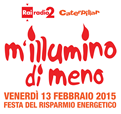2015 was declared by UNESCO as the “International Year of Light”.
In this context, the IAU (International Astronomical Union) promotes a global project titled “Cosmic Light and Light Quality” (www.iau.org/iyl), whose main goal is to draw attention to the light pollution of our skies and the benefits of responsible lighting.
 The phenomenon of light pollution, which began about a century ago with the spread of public lighting, is one of the most pervasive forms of pollution and affects over 60% of the world’s population. Excessive lighting dims the stars, making the sky unobservable from much of the globe.
The phenomenon of light pollution, which began about a century ago with the spread of public lighting, is one of the most pervasive forms of pollution and affects over 60% of the world’s population. Excessive lighting dims the stars, making the sky unobservable from much of the globe.
If we illuminated our cities without waste and directed lights only towards the ground where needed, we would not only save energy but also partially regain the view of the night sky and the stars.
For these reasons, taking advantage of the fact that for 11 years the radio program RAI2 – Caterpillar has promoted the energy-saving day “I light up less“, this year we propose an interesting national experiment on light pollution in which all citizens of any age can participate without special knowledge or tools for observing the sky!
 Caterpillar listeners will be invited to observe, on the evenings leading up to February 13 (the date of the “I light up less” initiative), from 6:00 PM to 7:30 PM, the constellation of the Little Dipper, or Little Bear, counting how many stars, out of the seven that make up the constellation, are visible. The observation should then be repeated on the evening of February 13, during the turning off of public and private lighting by those (and there are many!) who participate in the initiative. The difference between the number of stars visible during the blackout and those visible in full city lighting is a good measure of light pollution and the benefits that could be achieved by systematically reducing lighting: better efficiency, less waste, and, above all, less upward dispersion, all by “lighting up less… to see the stars again!”
Caterpillar listeners will be invited to observe, on the evenings leading up to February 13 (the date of the “I light up less” initiative), from 6:00 PM to 7:30 PM, the constellation of the Little Dipper, or Little Bear, counting how many stars, out of the seven that make up the constellation, are visible. The observation should then be repeated on the evening of February 13, during the turning off of public and private lighting by those (and there are many!) who participate in the initiative. The difference between the number of stars visible during the blackout and those visible in full city lighting is a good measure of light pollution and the benefits that could be achieved by systematically reducing lighting: better efficiency, less waste, and, above all, less upward dispersion, all by “lighting up less… to see the stars again!”
The experiment, as we said, is very simple and anyone can participate by following the instructions on the Italian site dedicated to the International Year of Light: iyl2015.inaf.it. It will be enough to locate, following the easy instructions, the constellation of the Little Dipper and the North Star: a useful exercise in case your GPS breaks and you need to find your way…!
[In the image: the North Star and two other stars of the Little Dipper are bright enough to be visible even among city lights, but the others, dimmer, will appear only where, due to the blackout, the sky has become darker.]
Participants in the experiment will be asked to indicate the postal code of the location from which they will observe the sky, so that in the end a national map of light pollution can be obtained and the most virtuous municipalities in turning off their lights can be identified.
Participating in this experiment, weather permitting, will also be Samantha Cristoforetti, who will photograph Italy from space on both February 12 and 13: let’s see if “I light up less” makes a difference!
Another important event on these topics will be held in those days in Turin with the multidisciplinary conference “Less Light, More Stars” taking place on February 13, 2015 at the historic headquarters of the Regional Council of Piedmont at Palazzo Lascaris in Turin. To register, simply visit the site: menolucepiustelle.oato.inaf.it.
The initiative “I light up less… to see the stars again” and “Less Light, More Stars” are organized with the support of the National Institute of Astrophysics, the Italian Astronomical Society, and the Italian Space Agency.
For information:
Caterina Boccato
INAF – Astronomical Observatory of Padua
0498293537
3498103522